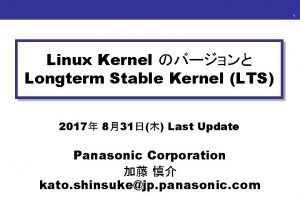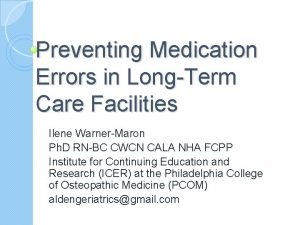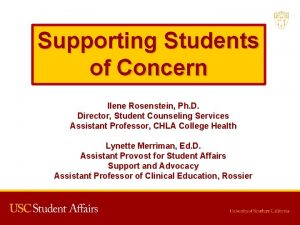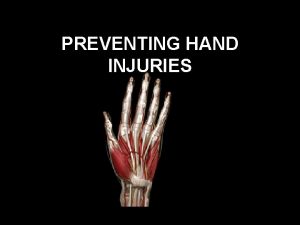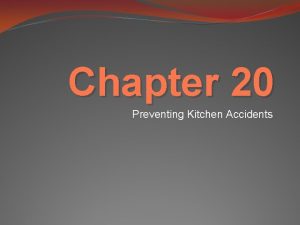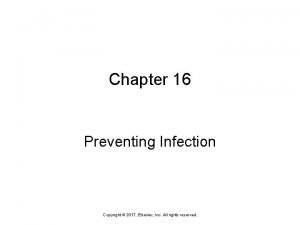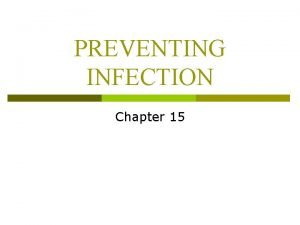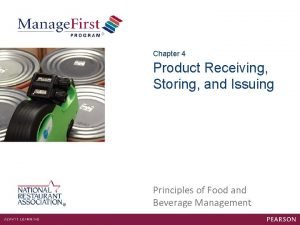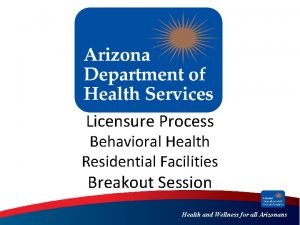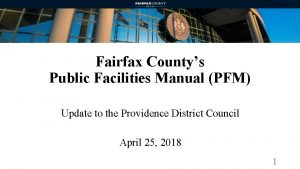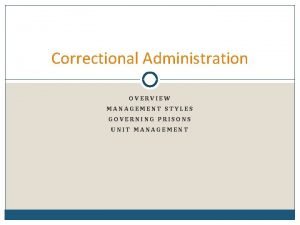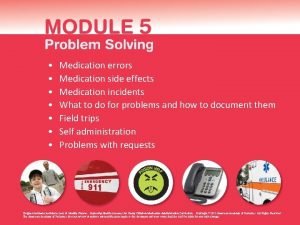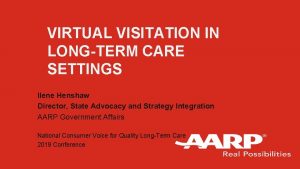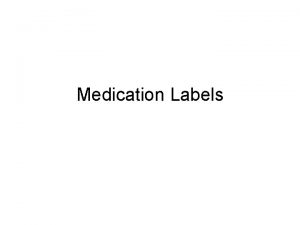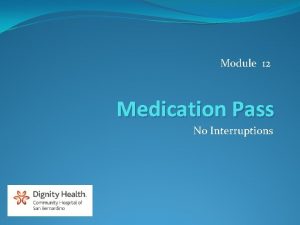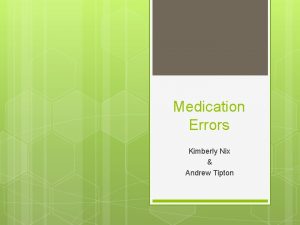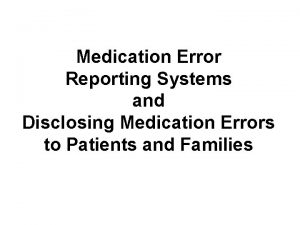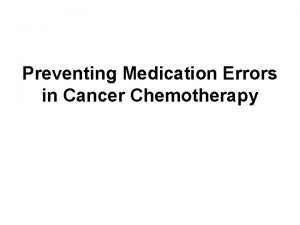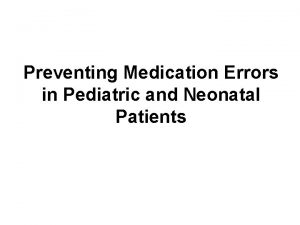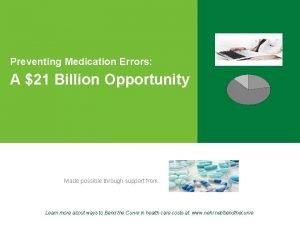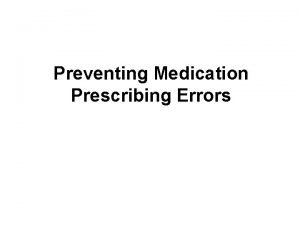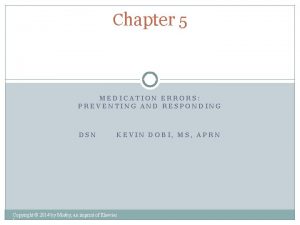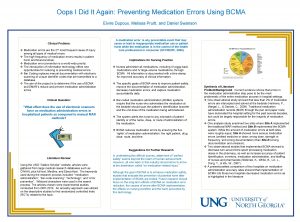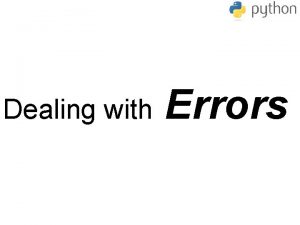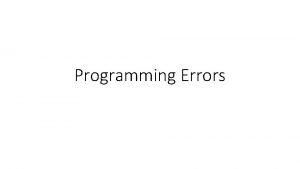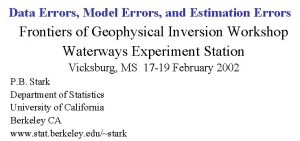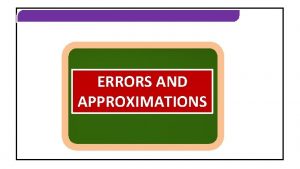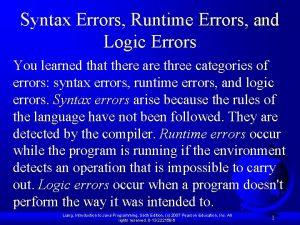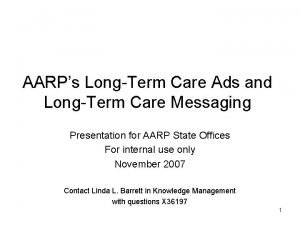Preventing Medication Errors in LongTerm Care Facilities Ilene































- Slides: 31

Preventing Medication Errors in Long-Term Care Facilities Ilene Warner-Maron Ph. D RN-BC CWCN CALA NHA FCPP Institute for Continuing Education and Research (ICER) at the Philadelphia College of Osteopathic Medicine (PCOM) aldengeriatrics@gmail. com

Goals of This Program �Using data collected from Pennsylvania Department of Health surveys 2009 -2012: ◦ Identify 3 factors that increase the risk of medication errors in long-term care ◦ Identify 5 issues most commonly cited with regard to medication errors ◦ Identify 5 interventions to decrease the incidence of these errors

How Long Does it Take for a Nurse to Administer 9: 00 a. m. medications in your facility?

Defining Medication Errors �An error occurs when the preparation or administration of a drug is not done in accordance with: ◦ Physician’s orders ◦ Manufacturer’s specifications ◦ Accepted professional standards and principles (by the author of the prescription, the dispensing pharmacist or the administrating nurse)

Physician/NP/PA-C Related. Errors � Handwriting leading to transcription errors � Lack of specificity regarding diagnosis, duration of treatment, frequency of administration � EMR related errors: wrong chart, wrong dose � Failure to review other medications and allergies before prescribing additional medications � Failing to identify the symptoms the new medication is treating are due to adverse drug reactions from medications already prescribed � Lack of physician-physician handoff communication during transitions of care � Covering physicians order medications for residents whom they know very little

“Do No Harm” has changed to “Do Something”

Pharmacy-Related Errors �Delivery issues �Expired medications in E-box, refrigerator �Dispensing errors ◦ Medication ◦ Dose �Failure ◦ ◦ to identify issues: Laboratory monitoring Drug-drug interactions Allergies Duplicategories of medications

Nursing-Related Issues �Failure to follow ◦ Right medication, dosage, resident, route, time �Failure to assess vital signs to monitor laboratory markers for medications with narrow therapeutic index (NTI) �Failure to assess the resident’s condition before administering the medication �Dose omissions, “holds, ” recaps, crushing �Friday at 5: 00 admissions � 24 -hour chart checks “done”

Administrative-Related Issues �Frequent Distractions/Care Changes �Communication between disciplines �Failure to identify medication diversion, reordering issues, multiple STAT orders, restocking E-box, borrowing from resident to resident �Inadequate attention to the role of the nurse administering medications �Lack of support/resources/supervision �Contract with pharmacy provider does not include requirement for medication pass observations, in-service education or consultations for residents with frequent falls

Federal Regulations � 42 C. F. R. section 483. 25(m): ◦ The facility must ensure that � 1. It is free of medication error rates of 5 percent or greater and � 2. Residents are free of any SIGNIFICANT medication errors The error rate is determined by N/D where the numerator is the total number of errors the survey team observes (significant and insignificant) over the denominator which is the total number of opportunities for error including all the doses of all the medications the survey team observed PLUS the doses that were ordered but not administered

Additional CMS Clarifications: Enteral Feeding Tubes �May also involve F 322 if: ◦ Placement of tube is not verified before administration of medications ◦ If residents on fluid restriction receive too many fluids with medications as well as flushes ◦ If each medication is not administered separately and flushed before and after administration (unless a physician specifies flushes should be limited due to fluid balance issues) ◦ F 425 pharmacy services may also be cited if there are inadequate policies as well as F 520 for QAA for quality assurance oversight of policies Failure to flush before and in between medications is considered a single medication error

Additional CMS Clarifications: MDI �If more that one puff is required, whether it is from the same or different medications, there is a 1 minute wait between puffs except for Albuterol and other short-acting agents where 15 -30 seconds is acceptable �Surveyors are citing facilities for the failure to have the resident rinse after steroid inhalers �Surveyors have been citing facilities regarding the ORDER that MDIs are given:

Additional CMS Clarifications: PPIs �Proton Pump Inhibitors (PPIs) such as Prevacid, Protonix, Nexium, Aciphex and Prilosec are more beneficial if given on an empty stomach, 30 -60 minutes before meals �Many older adults are prescribed this category of medications in the hospital but may not need to continue the medication in a nursing home or indefinitely �The duration and indication for use is required �May also involve F 281 Professional Standards of Quality, F 329 Unnecessary Medications and F 425 Pharmacy Services

Additional CMS Clarifications: Controlled Substances �Fentanyl (Duragesic) patches should be folded upon itself (sticky sides together) then placed in the sharps container with surveillance to prevent diversion or accidental exposure �Timely identification and removal of medications from the current supply �Identification of storage method for medications awaiting final disposition �Documentation by 2 nurses of actual destruction consistent with state and federal �Additional F 309 Qof. Care; F 425 Pharmacy; F 431 Controlled substances; F 514 Clinical records; F 520 QAA

Significant versus Insignificant Error �Significant errors cause discomfort or pain and jeopardize health and safety and are dependent upon: ◦ The resident’s underlying condition such as giving one dose of Lasix to a resident who is dehydrated ◦ The drug category, particularly medications with NTI ◦ The frequency of the error including repeated omissions, failure to observe “holds”

General Medication Errors Seen in the US Long-Term Care Facilities � Failure to shake � Giving meds before medications as required by the label � Mixing, rolling, creating air bubbles in insulin � Crushing medications on the no crush list � Incorrect amount or type of fluids given meals instead of with meals � Giving meds with meals instead of before � Failing to wait 3 -5 minutes between eye drops � Failing to administered MDI in the correct order and with sufficient time between puffs

Part D-Related Errors �Part D providers may require a substitution of a prescribed medication using a different formulary, adding further steps to the process of administration �Part D providers may substitute extended-release medications, requiring the use of shorting acting medications to be administered more frequently

Tracking and Reporting Errors �A Pennsylvania cautionary tale of Coumadin �Define categories of errors (prescribing, dispensing, administration, monitoring, compliance) �Develop a simple medication error reporting form and process for investigation �Increase education and knowledge of all types of errors �Conduct root cause analysis (RCA) as many issues are multi-factorial

Medication Errors PA DOH Citations 2009 -2012 �Methodology: surveys of all types reviewed for four years, noting citations for any type of medication error F 332 �Total number of surveys reviewed: 16, 125 �Total number of citations for all counties in PA: 738

Citations by County 20092012 County Number of Citations Allegheny 78 Lycoming 38 Montgomery 32 Washington 30 Northampton 29 Lancaster 28 Luzerne 25 Mifflin 24 Westmoreland 24 Northumberland 23 Mercer 22 Lebanon 21 Schuylkill 21

Types of Medication Errors 20092012 Type of Error Number of Citations Percent of Citations Wrong dose, calculation issues, spilled full dose, wrong strength 94 12. 74% Crushed inappropriately 82 11. 11% Not administered due to unavailability, missing 71 9. 62% Wrong time 60 8. 13% Should have been given with food or milk 59 7. 99% Should have been given in a fasting state 47 6. 37% MDI administered without rinsing 35 mouth 4. 74% Pharmacy delivery issues 27 3. 66% MDI administered too closely 24 3. 25%

Other Common PA DOH Citations � No/expired order � Infection control violations � Insufficient diluent � SSI timing issues � Eye drop technique/time between drops � Transcription errors � Recap errors � MAR does not match Controlled Drug log � E-box issues � Therapeutic Interchange error � Allergies � Acetaminophen dose exceeded � Cardiac medications not held despite vital signs outside of parameters

Other Common PA DOH Citations Failure to report significant medication errors to DOH � Anticoagulant doses not altered in accordance with PT/INR � LOA medications given without directions for family � Policy failures � Anemia medications given without monitoring laboratory results or obtaining parameters � Failure to remove one patch before placing another � No order for selfadministration � Pre-signing medications � Medication schedule not changed when dialysis schedule changed � Inadequate resident instruction � No gradual dose reductions for psychotropics � Incorrect medications from pharmacy �

Medication Caveats � SSI � Cathartics/stimulants � MDI requiring 8 ounces of water � Inhalers followed by pills � Labeling of OTC and supplements � Pre-authorized medication delays � Measurement of liquids � Thyroid preparations � Multiple forms of acetaminophen � Policies to cover NTG in case of angina � Medications that are every other day, weekly or monthly

Medication Caveats � OD, OS, OU artificial tears � Lidoderm over area of pain � Reading x 3 not done � Physician not informed when medications are unavailable � Delays in obtaining narcotics for new admissions � Nurse unaware of the reason a medication was administered � Nurse unaware of the differences in onset, peak and duration of insulins administered � Hospitalization for residents administered wrong drugs, allergies

Interventions �Split halls for 8 and 9 a. m. medications to allow for 3 hours of medication administration �Separate pharmacy provider from pharmacy consultant �Ensure monthly medication pass by pharmacy to desensitize nurses to observations �Reviews to decrease the number of medications in total and those administered at 9 a. m.

Interventions �Replace SSI with standard dosing for the individual resident �Anticoagulant flow sheets �Checking the 24 -hour chart check �Resources for Do Not Crush (ER, XL, LA, SR and other suffixes �In-services for the use of MDIs �Observations of nurses during med passes �Decreasing interruptions for nurses �Increased use of pharmacy consulting services for residents with falls and other potential issues related to medications

Interventions �Particular attention to “hold” medications and when to resume them �LOA instructions for medication use �BP in 2 positions at least weekly for residents on one or more antihypertensive agents �Understanding and disseminating information about policies, medication errors while maintaining an atmosphere where self-reporting errors is supported/expected � 48 hour oversight and multiple reviews of all new admissions

RCA �http: //www. jointcommission. org/Framewo rk_for_Conducting_a_Root_Cause_Anal ysis_and_Action_Plan/default. aspx �Issue: A resident was admitted for rehabilitation following a hospitalization for newly diagnosed Stage IV breast cancer. The oral chemotherapy agent was not administered during the entire 3 week admission

RCA for Missed Chemotherapy �Intended Process Flow �Missteps in Process �Human Factors �Equipment Failure �Environmental Factors �Organizational Factors �Staff Competence �Staffing �Information Readily Available �Communication Issues �Education �Technology

Resources American Society of Consultant Pharmacists (ASCP) Guidelines on Preventing Medication Errors in Pharmacies and Long-Term Care Facilities Through Reporting and Evaluation, 1997. Aronow, Wilbert S. Multiple Blood Pressure Medications and Mortality Among Elderly Individuals. Journal of the American Medical Association (JAMA) 2015; 313; (13): 13642 -4. Brady, Eric L. Medication Errors in the Nursing Home. Nursinghomefamilies. com Mixon, Amanda S et al. Characteristics Associated with Postdischarge Medication Errors. Mayo Clinic Proceedings 2014; 89(8): 1042 -1051 Munley, Evvie. CMS Memo Clarifies Nursing Home Survey Guidance for Medication Errors and Pharmacy Services. Leading. Age November 7, 2012. Stefanacci, RG and Spivack, BS. Preventing Medication Errors. Annals of Long-Term Care 2006; 14(10). Many thanks to my former colleague at St. Joseph’s University, Reecha
 Lts kernel
Lts kernel Thomas silverstein art
Thomas silverstein art How does vischer's theory prevent discrimination
How does vischer's theory prevent discrimination Ilene ochoa
Ilene ochoa Ilene warner
Ilene warner Ilene munk
Ilene munk Ilene rosenstein usc
Ilene rosenstein usc Primary secondary tertiary health care definition
Primary secondary tertiary health care definition Chapter 9 lesson 2 resolving conflicts
Chapter 9 lesson 2 resolving conflicts Which is mainly responsible for preventing erosion
Which is mainly responsible for preventing erosion Preventing kitchen accidents worksheet
Preventing kitchen accidents worksheet Preventing hand injuries
Preventing hand injuries Chapter 20 preventing kitchen accidents
Chapter 20 preventing kitchen accidents Chapter 13:2 preventing accidents and injuries
Chapter 13:2 preventing accidents and injuries Chapter 9 resolving conflicts and preventing violence
Chapter 9 resolving conflicts and preventing violence Workers compensation puncture
Workers compensation puncture Chapter 16 preventing infection
Chapter 16 preventing infection Chapter 4 preventing injuries through fitness
Chapter 4 preventing injuries through fitness Chapter 24 lesson 2 preventing and treating stds
Chapter 24 lesson 2 preventing and treating stds Preventing ageing unequally
Preventing ageing unequally Chapter 14:3 observing fire safety
Chapter 14:3 observing fire safety Chapter 15 preventing infection
Chapter 15 preventing infection Advantages of broadcast advertising
Advantages of broadcast advertising Issuing products
Issuing products Article 7 behavioral health residential facilities
Article 7 behavioral health residential facilities Fairfax pfm
Fairfax pfm Ancillary facilities construction
Ancillary facilities construction Facilities on the titanic
Facilities on the titanic Facilities vocabulary
Facilities vocabulary Leadership styles in correctional facilities
Leadership styles in correctional facilities Layout lokasi usaha
Layout lokasi usaha Vinci facilities maximo
Vinci facilities maximo
